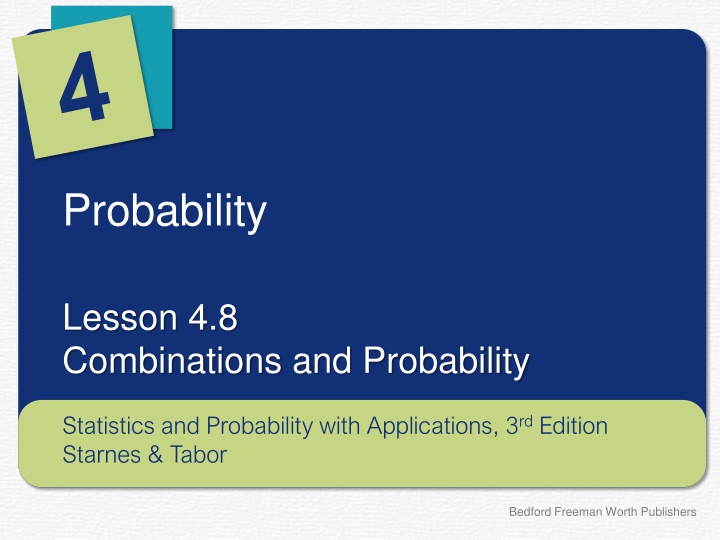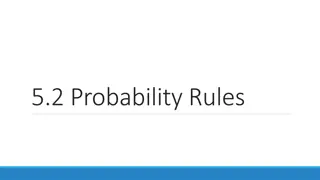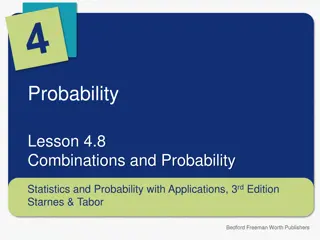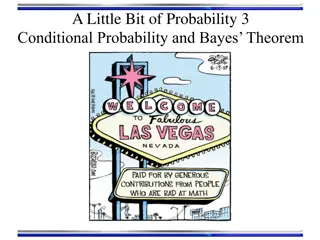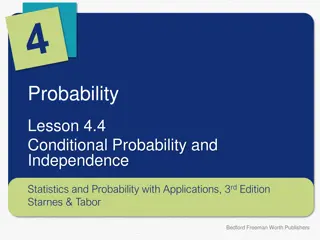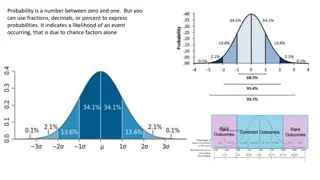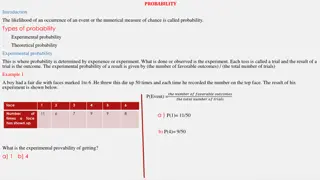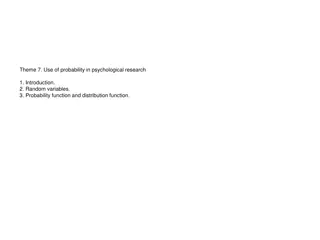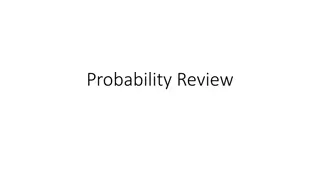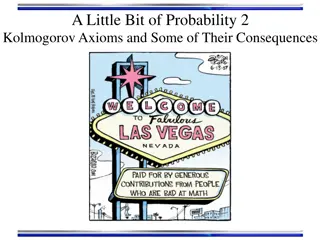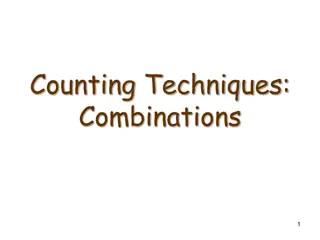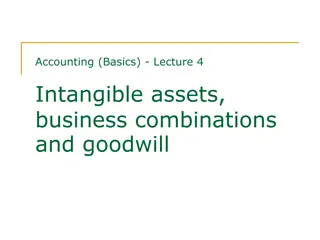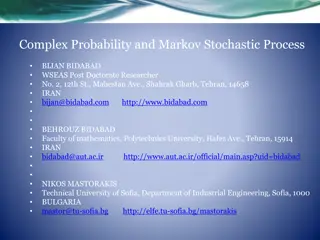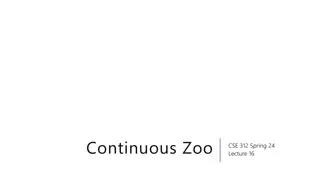Combinations and Probability in Statistics
Explore the concept of combinations and probability in statistics through lessons covering the computation of combinations, use of combinations to calculate probabilities, and application of the multiplication counting principle. Understand how to determine the number of different sets of selections and solve problems involving combinations in real-world scenarios. Enhance your knowledge to visualize and interpret the outcomes of chance processes using permutations and combinations.
Download Presentation

Please find below an Image/Link to download the presentation.
The content on the website is provided AS IS for your information and personal use only. It may not be sold, licensed, or shared on other websites without obtaining consent from the author.If you encounter any issues during the download, it is possible that the publisher has removed the file from their server.
You are allowed to download the files provided on this website for personal or commercial use, subject to the condition that they are used lawfully. All files are the property of their respective owners.
The content on the website is provided AS IS for your information and personal use only. It may not be sold, licensed, or shared on other websites without obtaining consent from the author.
E N D
Presentation Transcript
Probability Lesson 4.8 Combinations and Probability Statistics and Probability with Applications, 3rdEdition Starnes & Tabor Bedford Freeman Worth Publishers
Combinations and Probability Learning Targets After this lesson, you should be able to: Compute the number of combinations of n individuals taken k at a time. Use combinations to calculate probabilities. Use the multiplication counting principle and combinations to calculate probabilities. Statistics and Probability with Applications, 3rdEdition 2 2
Combinations and Probability Recall that a permutation is a distinct arrangement of some group of individuals. With permutations, order matters. Sometimes, we re just interested in finding how many ways there are to choose some number of individuals from a group, but we don t care about the order in which the individuals are selected. nCk Combinations, A combination is a selection of individuals from some group in which the order of selection doesn t matter. If there are n individuals, then the notation nCk represents the number of different combinations of k individuals chosen from the entire group of n. Statistics and Probability with Applications, 3rdEdition 3 3
Combinations and Probability How to Compute Combinations You can calculate the number of combinations of n individuals taken k at a time (where k n) using the multiplication counting principle, with the formula or with the formula Statistics and Probability with Applications, 3rd Edition 4 4
Who screams for ice cream? Who screams for ice cream? Combinations Combinations PROBLEM: Mr. Starnes loves ice cream. The local ice-cream stand offers a triple-scoop dish of ice cream. The stand has 15 different ice- cream flavors, and Mr. Starnes always chooses three different flavors for his dish. How many different sets of three flavors can Mr. Starnes choose for his dish? There are 15 14 13 3 2 1 P = = = 455 15 3 C 15 3 3! different sets of three flavors that Mr. Starnes can choose. Statistics and Probability with Applications, 3rd Edition 5 5
Combinations and Probability The focus of this chapter is probability. Recall that when a chance process results in equally likely outcomes, the probability that event A occurs is You can use the multiplication counting principle and what you have learned about permutations and combinations to help count the number of outcomes. Statistics and Probability with Applications, 3rd Edition 6 6
Combinations and Probability Consider New Jersey s Pick Six lotto game from the previous example. What s the probability that a player wins the jackpot by matching all 6 winning numbers? Because the winning numbers are randomly selected, any set of 6 numbers from 1 to 49 is equally likely to be chosen. So we can use the probability formula to calculate Statistics and Probability with Applications, 3rd Edition 7 7
What else is there for lunch? What else is there for lunch? From counting to probability From counting to probability PROBLEM: Your school cafeteria has purchased enough food for 12 different lunches over the next few weeks, 5 of which include some sort of pasta. Due to a holiday on Monday, there are only 4 school days this week. The cafeteria workers plan to randomly select 4 different lunches from the 12 lunches to serve this week. What is the probability that all 4 meals this week will include pasta? # of ways to choose 4 pasta lunches out of 5 (4 pasta lunches selected) Total # of ways to choose 4 lunches from all lunches C C 1 12 11 10 9 8 7 6 5 4 3 2 1 5 = 0.010 495 = P = 5 4 12 4 5 4 3 2 4 3 2 = Statistics and Probability with Applications, 3rd Edition 8 8
Were there selection shenanigans? Were there selection shenanigans? Finding probabilities with combinations Finding probabilities with combinations PROBLEM: The student council at a local high school consists of 10 juniors and 30 seniors who are advised by a teacher. The state Association of Student Councils is holding a conference and the school has enough funds to send only 6 students. The student council advisor decided that 6 students will be selected at random to go to the conference. The advisor conducted a drawing one night after school and announced the results the next day: 4 juniors and 2 seniors would go. The seniors were concerned that the advisor may not have used random chance to decide because so few seniors were chosen. (a) Find the number of ways in which a randomly chosen group of six student council members could result in 4 juniors and 2 seniors being selected. (b) Find the probability that random selection would result in 4 juniors and 2 seniors being chosen for the conference. (c) Based on your answer to (b), is there convincing evidence that the selection process wasn t carried out by random chance? Explain. Statistics and Probability with Applications, 3rd Edition 9 9
Were there selection shenanigans? Were there selection shenanigans? Finding probabilities with combinations Finding probabilities with combinations (a) Find the number of ways in which a randomly chosen group of six student council members could result in 4 juniors and 2 seniors being selected. (a) There are 10C4 30C2 juniors seniors ways to select 4 juniors and 2 seniors to go to the conference. Statistics and Probability with Applications, 3rd Edition 10 10
Were there selection shenanigans? Were there selection shenanigans? Finding probabilities with combinations Finding probabilities with combinations (b) Find the probability that random selection would result in 4 juniors and 2 seniors being chosen for the conference. The number of ways to randomly select 6 of the 40 students is 40 39 38 37 36 35 6 5 4 3 2 1 2,763,633,600 720 3,838,380 = C 40 6 = = Statistics and Probability with Applications, 3rd Edition 11 11
Were there selection shenanigans? Were there selection shenanigans? Finding probabilities with combinations Finding probabilities with combinations (b) Find the probability that random selection would result in 4 juniors and 2 seniors being chosen for the conference. Each of these 3,838,380 possible sets of 6 students is equally likely to be selected, so P(4 junior and 2 seniors selected by random chance) number of ways to get 4 juniors and 2 seniors total number of ways to select 6 students C C = C = 10 4 30 2 40 6 91,350 3,838,380 0.024 = Statistics and Probability with Applications, 3rd Edition 12 12
Were there selection shenanigans? Were there selection shenanigans? Finding probabilities with combinations Finding probabilities with combinations (c) Based on your answer to (b), is there convincing evidence that the selection process wasn t carried out by random chance? Explain. Yes. There is only about a 2.4% chance that a random selection would result in 4 juniors and 2 seniors being selected. Statistics and Probability with Applications, 3rd Edition 13 13
LESSON APP 4.8 How many ways can you set up an iPod playlist? Janine wants to set up a play list with 8 songs on her iPod. She has 50 songs to choose from, including 15 songs by One Direction. Janine s iPod won t allow any song to appear more than once in a play list. 1. How many different sets of 8 songs are possible for Janine s play list? Assume that the order of the songs doesn t matter. How many 8-song play lists contain no songs by One Direction? 2. Suppose Janine decides to let her iPod select an 8-song play list at random. 3. 4. What s the probability that none of the 8 songs is by One Direction? Find the probability that exactly 2 of the songs on the play list are by One Direction. Statistics and Probability with Applications, 3rd Edition 14 14
LESSON APP 4.8 1. How many different sets of 8 songs are possible for Janine s play list? Assume that the order of the songs doesn t matter. How many ways can you set up an iPod playlist? 2. How many 8-song play lists contain no songs by One Direction? Statistics and Probability with Applications, 3rd Edition 15 15
LESSON APP 4.8 3. What s the probability that none of the 8 songs is by One Direction? How many ways can you set up an iPod playlist? 4. Find the probability that exactly 2 of the songs on the play list are by One Direction. Statistics and Probability with Applications, 3rd Edition 16 16
Combinations and Probability Learning Targets After this lesson, you should be able to: Compute the number of combinations of n individuals taken k at a time. Use combinations to calculate probabilities. Use the multiplication counting principle and combinations to calculate probabilities. Statistics and Probability with Applications, 3rd Edition 17 17
